Dual-MTGAN: Stochastic and Deterministic Motion Transfer for Image-To-Video Synthesis
Fu-En Yang,
Jing-Cheng Chang,
Yuan-Hao Lee,
Yu-Chiang Frank Wang

Auto-TLDR; Dual Motion Transfer GAN for Convolutional Neural Networks
Similar papers
The Role of Cycle Consistency for Generating Better Human Action Videos from a Single Frame

Auto-TLDR; Generating Videos with Human Action Semantics using Cycle Constraints
Abstract Slides Poster Similar
Mutual Information Based Method for Unsupervised Disentanglement of Video Representation
Aditya Sreekar P, Ujjwal Tiwari, Anoop Namboodiri

Auto-TLDR; MIPAE: Mutual Information Predictive Auto-Encoder for Video Prediction
Abstract Slides Poster Similar
Reducing the Variance of Variational Estimates of Mutual Information by Limiting the Critic's Hypothesis Space to RKHS
Aditya Sreekar P, Ujjwal Tiwari, Anoop Namboodiri

Auto-TLDR; Mutual Information Estimation from Variational Lower Bounds Using a Critic's Hypothesis Space
Learning to Take Directions One Step at a Time
Qiyang Hu, Adrian Wälchli, Tiziano Portenier, Matthias Zwicker, Paolo Favaro

Auto-TLDR; Generating a Sequence of Motion Strokes from a Single Image
Abstract Slides Poster Similar
Learning Interpretable Representation for 3D Point Clouds
Feng-Guang Su, Ci-Siang Lin, Yu-Chiang Frank Wang

Auto-TLDR; Disentangling Body-type and Pose Information from 3D Point Clouds Using Adversarial Learning
Abstract Slides Poster Similar
Let's Play Music: Audio-Driven Performance Video Generation
Hao Zhu, Yi Li, Feixia Zhu, Aihua Zheng, Ran He

Auto-TLDR; APVG: Audio-driven Performance Video Generation Using Structured Temporal UNet
Abstract Slides Poster Similar
Future Urban Scenes Generation through Vehicles Synthesis
Alessandro Simoni, Luca Bergamini, Andrea Palazzi, Simone Calderara, Rita Cucchiara

Auto-TLDR; Predicting the Future of an Urban Scene with a Novel View Synthesis Paradigm
Abstract Slides Poster Similar
Local Facial Attribute Transfer through Inpainting
Ricard Durall, Franz-Josef Pfreundt, Janis Keuper

Auto-TLDR; Attribute Transfer Inpainting Generative Adversarial Network
Abstract Slides Poster Similar
GarmentGAN: Photo-Realistic Adversarial Fashion Transfer
Amir Hossein Raffiee, Michael Sollami

Auto-TLDR; GarmentGAN: A Generative Adversarial Network for Image-Based Garment Transfer
Abstract Slides Poster Similar
Self-Supervised Learning of Dynamic Representations for Static Images
Siyang Song, Enrique Sanchez, Linlin Shen, Michel Valstar

Auto-TLDR; Facial Action Unit Intensity Estimation and Affect Estimation from Still Images with Multiple Temporal Scale
Abstract Slides Poster Similar
Learning Disentangled Representations for Identity Preserving Surveillance Face Camouflage
Jingzhi Li, Lutong Han, Hua Zhang, Xiaoguang Han, Jingguo Ge, Xiaochu Cao

Auto-TLDR; Individual Face Privacy under Surveillance Scenario with Multi-task Loss Function
Motion-Supervised Co-Part Segmentation
Aliaksandr Siarohin, Subhankar Roy, Stéphane Lathuiliere, Sergey Tulyakov, Elisa Ricci, Nicu Sebe

Auto-TLDR; Self-supervised Co-Part Segmentation Using Motion Information from Videos
Learning Low-Shot Generative Networks for Cross-Domain Data
Hsuan-Kai Kao, Cheng-Che Lee, Wei-Chen Chiu

Auto-TLDR; Learning Generators for Cross-Domain Data under Low-Shot Learning
Abstract Slides Poster Similar
Coherence and Identity Learning for Arbitrary-Length Face Video Generation
Shuquan Ye, Chu Han, Jiaying Lin, Guoqiang Han, Shengfeng He

Auto-TLDR; Face Video Synthesis Using Identity-Aware GAN and Face Coherence Network
Abstract Slides Poster Similar
Unsupervised Contrastive Photo-To-Caricature Translation Based on Auto-Distortion
Yuhe Ding, Xin Ma, Mandi Luo, Aihua Zheng, Ran He

Auto-TLDR; Unsupervised contrastive photo-to-caricature translation with style loss
Abstract Slides Poster Similar
Facial Expression Recognition by Using a Disentangled Identity-Invariant Expression Representation
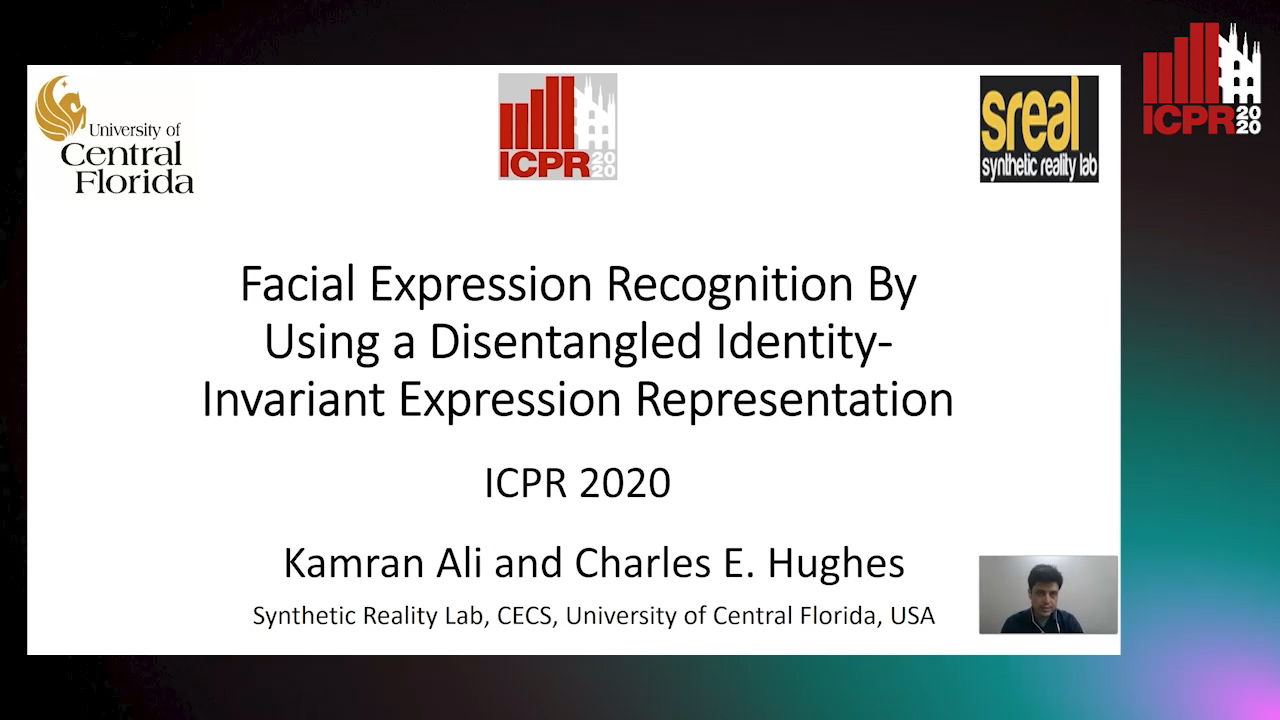
Auto-TLDR; Transfer-based Expression Recognition Generative Adversarial Network (TER-GAN)
Abstract Slides Poster Similar
Semantics-Guided Representation Learning with Applications to Visual Synthesis
Jia-Wei Yan, Ci-Siang Lin, Fu-En Yang, Yu-Jhe Li, Yu-Chiang Frank Wang
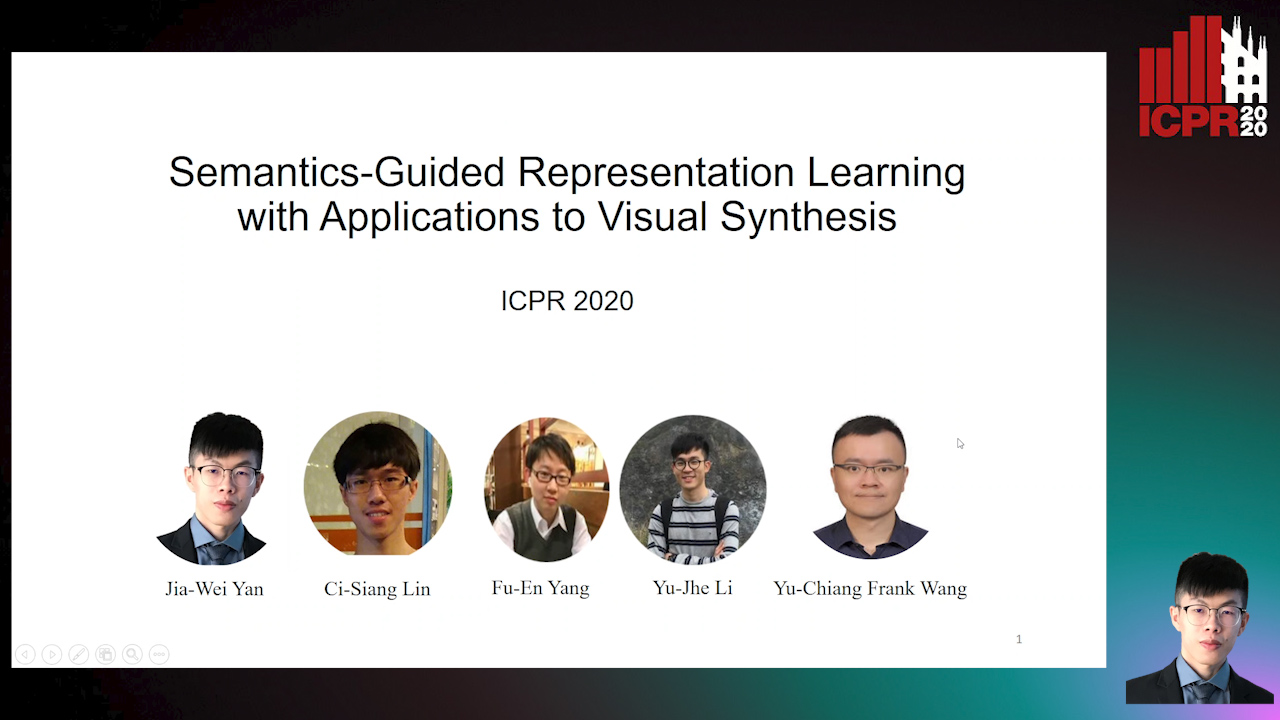
Auto-TLDR; Learning Interpretable and Interpolatable Latent Representations for Visual Synthesis
Abstract Slides Poster Similar
Disentangle, Assemble, and Synthesize: Unsupervised Learning to Disentangle Appearance and Location
Hiroaki Aizawa, Hirokatsu Kataoka, Yutaka Satoh, Kunihito Kato

Auto-TLDR; Generative Adversarial Networks with Structural Constraint for controllability of latent space
Abstract Slides Poster Similar
Shape Consistent 2D Keypoint Estimation under Domain Shift
Levi Vasconcelos, Massimiliano Mancini, Davide Boscaini, Barbara Caputo, Elisa Ricci

Auto-TLDR; Deep Adaptation for Keypoint Prediction under Domain Shift
Abstract Slides Poster Similar
Talking Face Generation Via Learning Semantic and Temporal Synchronous Landmarks
Aihua Zheng, Feixia Zhu, Hao Zhu, Mandi Luo, Ran He

Auto-TLDR; A semantic and temporal synchronous landmark learning method for talking face generation
Abstract Slides Poster Similar
Exemplar Guided Cross-Spectral Face Hallucination Via Mutual Information Disentanglement
Haoxue Wu, Huaibo Huang, Aijing Yu, Jie Cao, Zhen Lei, Ran He

Auto-TLDR; Exemplar Guided Cross-Spectral Face Hallucination with Structural Representation Learning
Abstract Slides Poster Similar
High Resolution Face Age Editing
Xu Yao, Gilles Puy, Alasdair Newson, Yann Gousseau, Pierre Hellier

Auto-TLDR; An Encoder-Decoder Architecture for Face Age editing on High Resolution Images
Abstract Slides Poster Similar
Unsupervised Disentangling of Viewpoint and Residues Variations by Substituting Representations for Robust Face Recognition
Minsu Kim, Joanna Hong, Junho Kim, Hong Joo Lee, Yong Man Ro

Auto-TLDR; Unsupervised Disentangling of Identity, viewpoint, and Residue Representations for Robust Face Recognition
Abstract Slides Poster Similar
Unsupervised Face Manipulation Via Hallucination
Keerthy Kusumam, Enrique Sanchez, Georgios Tzimiropoulos

Auto-TLDR; Unpaired Face Image Manipulation using Autoencoders
Abstract Slides Poster Similar
Cascade Attention Guided Residue Learning GAN for Cross-Modal Translation
Bin Duan, Wei Wang, Hao Tang, Hugo Latapie, Yan Yan

Auto-TLDR; Cascade Attention-Guided Residue GAN for Cross-modal Audio-Visual Learning
Abstract Slides Poster Similar
Free-Form Image Inpainting Via Contrastive Attention Network
Xin Ma, Xiaoqiang Zhou, Huaibo Huang, Zhenhua Chai, Xiaolin Wei, Ran He

Auto-TLDR; Self-supervised Siamese inference for image inpainting
JUMPS: Joints Upsampling Method for Pose Sequences
Lucas Mourot, Francois Le Clerc, Cédric Thébault, Pierre Hellier

Auto-TLDR; JUMPS: Increasing the Number of Joints in 2D Pose Estimation and Recovering Occluded or Missing Joints
Abstract Slides Poster Similar
Detail Fusion GAN: High-Quality Translation for Unpaired Images with GAN-Based Data Augmentation
Ling Li, Yaochen Li, Chuan Wu, Hang Dong, Peilin Jiang, Fei Wang

Auto-TLDR; Data Augmentation with GAN-based Generative Adversarial Network
Abstract Slides Poster Similar
Pixel-based Facial Expression Synthesis
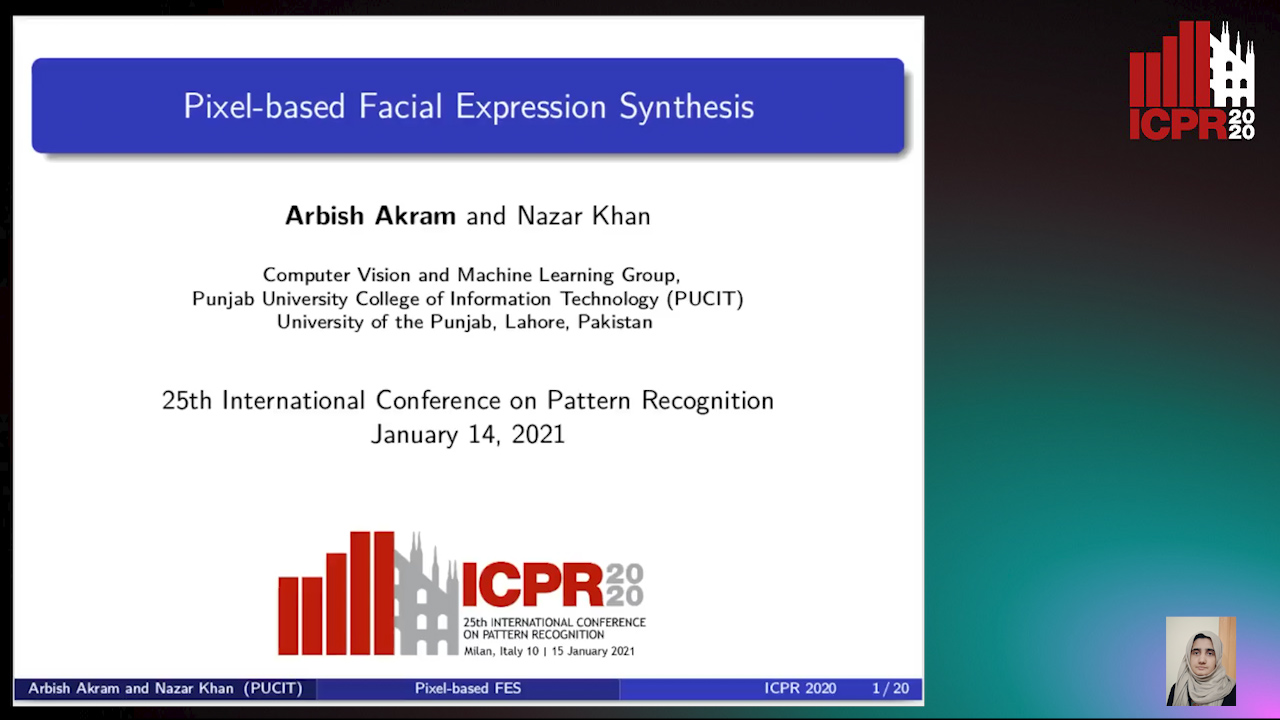
Auto-TLDR; pixel-based facial expression synthesis using GANs
Abstract Slides Poster Similar
Galaxy Image Translation with Semi-Supervised Noise-Reconstructed Generative Adversarial Networks
Qiufan Lin, Dominique Fouchez, Jérôme Pasquet

Auto-TLDR; Semi-supervised Image Translation with Generative Adversarial Networks Using Paired and Unpaired Images
Abstract Slides Poster Similar
Mask-Based Style-Controlled Image Synthesis Using a Mask Style Encoder
Jaehyeong Cho, Wataru Shimoda, Keiji Yanai

Auto-TLDR; Style-controlled Image Synthesis from Semantic Segmentation masks using GANs
Abstract Slides Poster Similar
Controllable Face Aging

Auto-TLDR; A controllable face aging method via attribute disentanglement generative adversarial network
Abstract Slides Poster Similar
Boundary Guided Image Translation for Pose Estimation from Ultra-Low Resolution Thermal Sensor
Kohei Kurihara, Tianren Wang, Teng Zhang, Brian Carrington Lovell

Auto-TLDR; Pose Estimation on Low-Resolution Thermal Images Using Image-to-Image Translation Architecture
Abstract Slides Poster Similar
Cycle-Consistent Adversarial Networks and Fast Adaptive Bi-Dimensional Empirical Mode Decomposition for Style Transfer
Elissavet Batziou, Petros Alvanitopoulos, Konstantinos Ioannidis, Ioannis Patras, Stefanos Vrochidis, Ioannis Kompatsiaris

Auto-TLDR; FABEMD: Fast and Adaptive Bidimensional Empirical Mode Decomposition for Style Transfer on Images
Abstract Slides Poster Similar
Unsupervised 3D Human Pose Estimation in Multi-view-multi-pose Video
Cheng Sun, Diego Thomas, Hiroshi Kawasaki
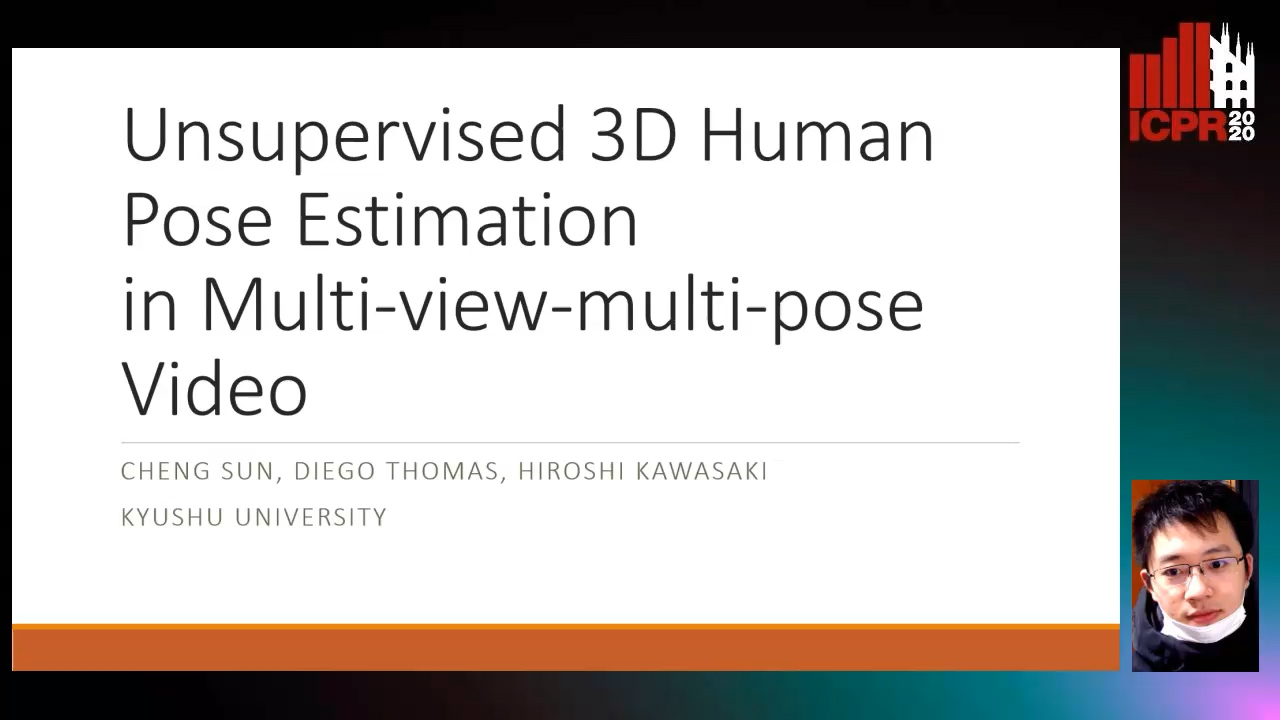
Auto-TLDR; Unsupervised 3D Human Pose Estimation from 2D Videos Using Generative Adversarial Network
Abstract Slides Poster Similar
Semantic-Guided Inpainting Network for Complex Urban Scenes Manipulation
Pierfrancesco Ardino, Yahui Liu, Elisa Ricci, Bruno Lepri, Marco De Nadai

Auto-TLDR; Semantic-Guided Inpainting of Complex Urban Scene Using Semantic Segmentation and Generation
Abstract Slides Poster Similar
A Quantitative Evaluation Framework of Video De-Identification Methods
Sathya Bursic, Alessandro D'Amelio, Marco Granato, Giuliano Grossi, Raffaella Lanzarotti

Auto-TLDR; Face de-identification using photo-reality and facial expressions
Abstract Slides Poster Similar
Disentangled Representation Learning for Controllable Image Synthesis: An Information-Theoretic Perspective
Shichang Tang, Xu Zhou, Xuming He, Yi Ma
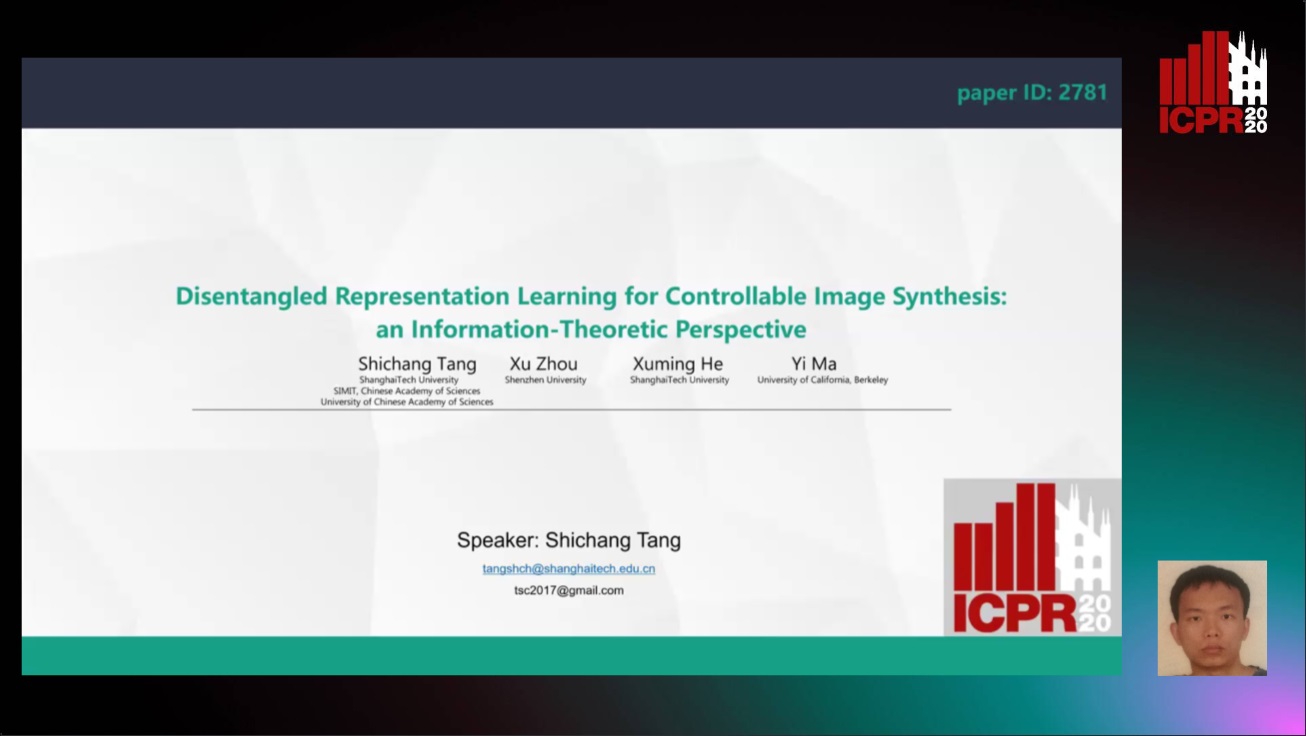
Auto-TLDR; Controllable Image Synthesis in Deep Generative Models using Variational Auto-Encoder
Abstract Slides Poster Similar
Identity-Aware Facial Expression Recognition in Compressed Video
Xiaofeng Liu, Linghao Jin, Xu Han, Jun Lu, Jonghye Woo, Jane You

Auto-TLDR; Exploring Facial Expression Representation in Compressed Video with Mutual Information Minimization
Deep Multi-Task Learning for Facial Expression Recognition and Synthesis Based on Selective Feature Sharing
Rui Zhao, Tianshan Liu, Jun Xiao, P. K. Daniel Lun, Kin-Man Lam

Auto-TLDR; Multi-task Learning for Facial Expression Recognition and Synthesis
Abstract Slides Poster Similar
Multi-Domain Image-To-Image Translation with Adaptive Inference Graph
The Phuc Nguyen, Stéphane Lathuiliere, Elisa Ricci

Auto-TLDR; Adaptive Graph Structure for Multi-Domain Image-to-Image Translation
Abstract Slides Poster Similar
AVAE: Adversarial Variational Auto Encoder
Antoine Plumerault, Hervé Le Borgne, Celine Hudelot

Auto-TLDR; Combining VAE and GAN for Realistic Image Generation
Abstract Slides Poster Similar
What and How? Jointly Forecasting Human Action and Pose
Yanjun Zhu, Yanxia Zhang, Qiong Liu, Andreas Girgensohn

Auto-TLDR; Forecasting Human Actions and Motion Trajectories with Joint Action Classification and Pose Regression
Abstract Slides Poster Similar
UCCTGAN: Unsupervised Clothing Color Transformation Generative Adversarial Network
Shuming Sun, Xiaoqiang Li, Jide Li

Auto-TLDR; An Unsupervised Clothing Color Transformation Generative Adversarial Network
Abstract Slides Poster Similar
VITON-GT: An Image-Based Virtual Try-On Model with Geometric Transformations
Matteo Fincato, Federico Landi, Marcella Cornia, Fabio Cesari, Rita Cucchiara
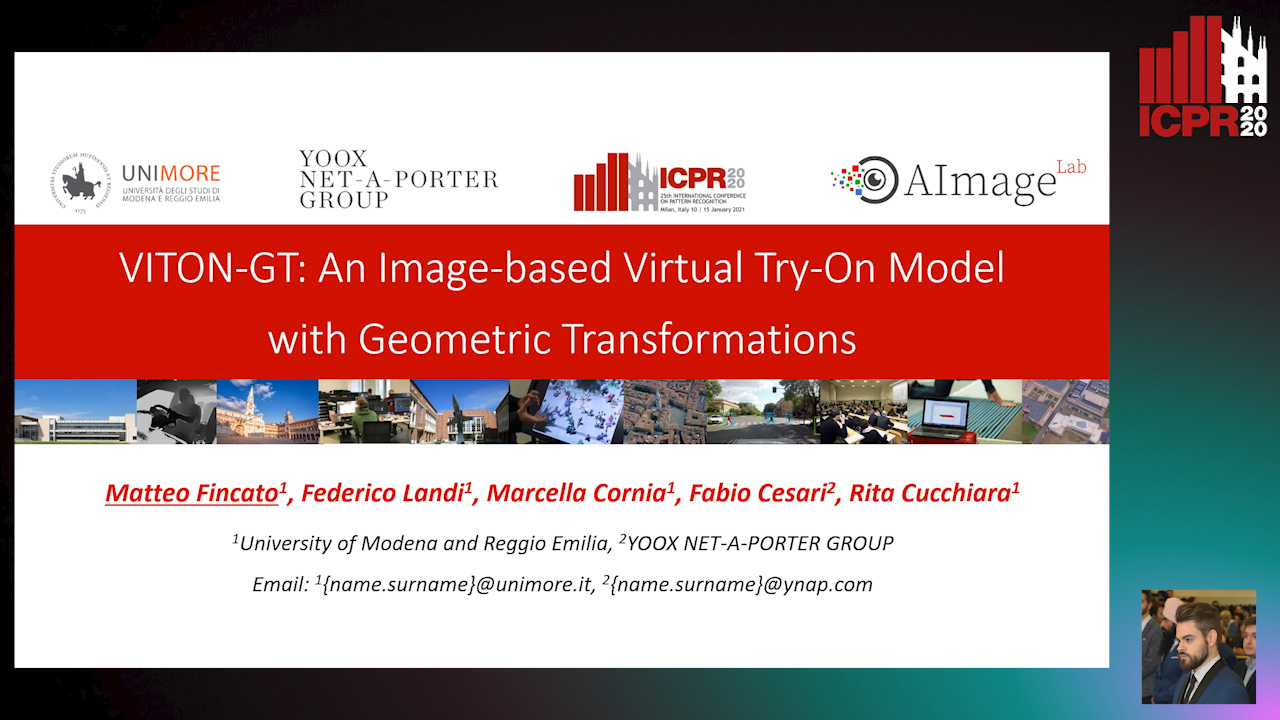
Auto-TLDR; VITON-GT: An Image-based Virtual Try-on Architecture for Fashion Catalogs
Abstract Slides Poster Similar
Continuous Learning of Face Attribute Synthesis
Ning Xin, Shaohui Xu, Fangzhe Nan, Xiaoli Dong, Weijun Li, Yuanzhou Yao

Auto-TLDR; Continuous Learning for Face Attribute Synthesis
Abstract Slides Poster Similar
SIDGAN: Single Image Dehazing without Paired Supervision
Pan Wei, Xin Wang, Lei Wang, Ji Xiang, Zihan Wang

Auto-TLDR; DehazeGAN: An End-to-End Generative Adversarial Network for Image Dehazing
Abstract Slides Poster Similar
Pose Variation Adaptation for Person Re-Identification
Lei Zhang, Na Jiang, Qishuai Diao, Yue Xu, Zhong Zhou, Wei Wu

Auto-TLDR; Pose Transfer Generative Adversarial Network for Person Re-identification
Abstract Slides Poster Similar